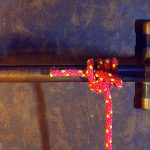Sheepshank
How to Tie the Sheepshank
The thing to remember when tying the sheepshank in it’s simplest form, is that it will only hold whilst there is tension on the rope. According to The Art of Knotting and Splicing, the Sheepshank can sometimes collapse whilst under heavy tension. For additional security toggles can be inserted at the loop ends of the Sheepshank. You can also check out Strength of Knot Chart to establish how effective the Sheepshank is.
How to Tie the Sheepshank Marlinespike Hitch Method
When tying a sheepshank, additional security can also be achieved by using the Marlinespike Hitch at either end. Using a Marlinespike Hitch does offer a bit of added security, by holding the sheepshank in place when the rope is slack. However, which ever method of Sheepshank you are using, you should always check the knot when the line has been allowed to slacken off.
How to Tie a Sheepshank Video
In this video I will show a couple of variations of tying the Sheepshank. One problem with a sheepshank is that the Sheepshank can too easily fall apart if the rope is not under constant tension. So included is a variant that incorporates the Marlin Spike Hitch.
What is a Sheepshank Used For?
Generally the Sheepshank is a great way of shortening a length of rope that is too long, without the need of cutting the rope. It can also be used to bypass a section of damaged rope. Often the Sheepshank is used in conjunction with other knots to tie-down a load that forms part of the Truckers Hitch.
Sheepshank and Truckers Hitch
Often the Sheepshank is used as part of a truckers hitch. A search of the internet will show a number of variation of the Truckers Hitch, which will have the Sheepshank incorporated as part of the tie-down system. I would also recommend at the same time, doing a search for the Trukies Hitch (not 100% sure on Trukkies spelling).








Comments
Sheepshank — No Comments
HTML tags allowed in your comment: <a href="" title=""> <abbr title=""> <acronym title=""> <b> <blockquote cite=""> <cite> <code> <del datetime=""> <em> <i> <q cite=""> <s> <strike> <strong>